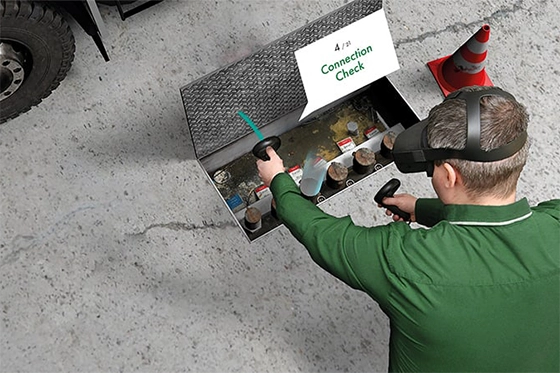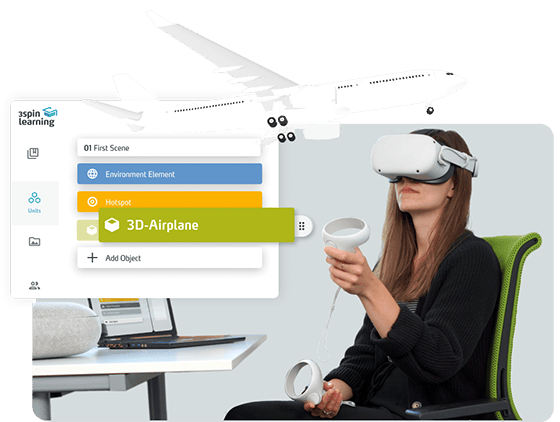VR / AR & AI Aviation
Taking Aviation To New Heights Thanks To Virtual Reality
VR / AR & AI offer unique opportunities in the aviation sector to improve training and education programs, optimize maintenance and repair processes, and overall increase customer satisfaction.

Greater Success Thanks To VR / AR & AI in the Aviation and Aerospace Industry

 15%
15%
Performance improvement for student pilots
Reduces need for a physical simulator cabin
Providing a cheaper method of training
Pilot Training Made Simple
Grow your training potential with the help of state-of-the-art VR/ AR & AI training tools specially developed for aviation.
Immerse your students in realistic training situations
VR / AR & AI for measurable learning success and immediate feedback

15% Increase in Student Pilot Performance
Lufthansa Aviation Training succeeded in increasing the performance of its student pilots by 15% by using mobile VR training in basic training under visual flight rules.

VR Experience Leads to 50% Higher Sales Due to Better Informed Customers
Lufthansa increased the upgrade rate for Premium Economy by 50% thanks to customized 360-degree upselling services with the help of targeted product information.

Cost-effective Cabin Crew Training
Eurowings Discover uses VR for the efficient and cost-effective training of its cabin crew.

Augmented & Virtual Reality will add great value to aviation training in the future.
More Use Cases
Aviation Aptitude Assessment
The immersive and interactive nature of VR and AR-based devices enables a more comprehensive and realistic evaluation of candidates' aptitude for aviation. For example, it can help with cognitive abilities assessments, situational awareness evaluation, decision-making and crisis management skills, and hand-eye coordination and motor skills assessment.
Cockpit Familiarization
VR can simulate different cockpit environments, allowing pilots-in-training to become familiar with the layout, instruments, controls, and systems of different aircraft types. They can practice cockpit procedures, switchology, and emergency scenarios in a realistic virtual environment, facilitating a smoother transition to actual flight training.
Pilot Proficiency Training
Virtual and Augmented Reality can complement traditional flight training by providing additional practice sessions and allowing pilots to refine their skills in specific areas. Virtual environments can be customized to replicate challenging scenarios, such as low-visibility landings, mountainous terrain, or congested airspace, enabling pilots to train in a more cost-effective and versatile manner. The scenarios can be customized to simulate different aircraft types, weather conditions, and airports, allowing pilots to train in diverse and challenging situations.
Emergency Procedures Training
In simulated emergency scenarios, pilots practice critical decision-making and emergency procedures in a controlled and safe environment. This way, trainees experience realistic simulations of engine failures, system malfunctions, adverse weather conditions, and other challenging situations, improving their ability to respond effectively in real-world emergencies.
Air Traffic Control (ATC) Training
Air traffic controller trainees can practice managing air traffic, monitoring radar displays, communicating with pilots, and making decisions in high-pressure situations.
Aircraft Marshalling
VR can support training to perfectly master visual contact with aircraft, proper communication gestures, and parking area rules.
Aerospace Manufacturing Training
VR and AR training can be utilized in aerospace manufacturing facilities to train workers in assembly processes, quality control, and equipment operation. By overlaying digital information onto physical workstations or providing interactive virtual simulations, trainees can learn complex manufacturing procedures more effectively and reduce errors.
Space Exploration Training
Simulating space environments help astronauts train for space missions. From practicing extravehicular activities (EVAs) to operating spacecraft systems, astronauts can use this technology to familiarize themselves with the unique challenges of space exploration and refine their skills in a simulated space environment.
Organizations Using 3spin Learning













More Success Stories from our Customers


Lufthansa Aviation Training achieved a 15 per cent increase in the performance of student pilots


With 3spin Learning's authoring tool, Avacon trainees create their own learning courses just like PowerPoint


Enabling staff to train on difficult or impossible-to-simulate objects with Virtual Reality



VR training platform provides Boehringer Ingelheim with faster and safer learning in laboratories











